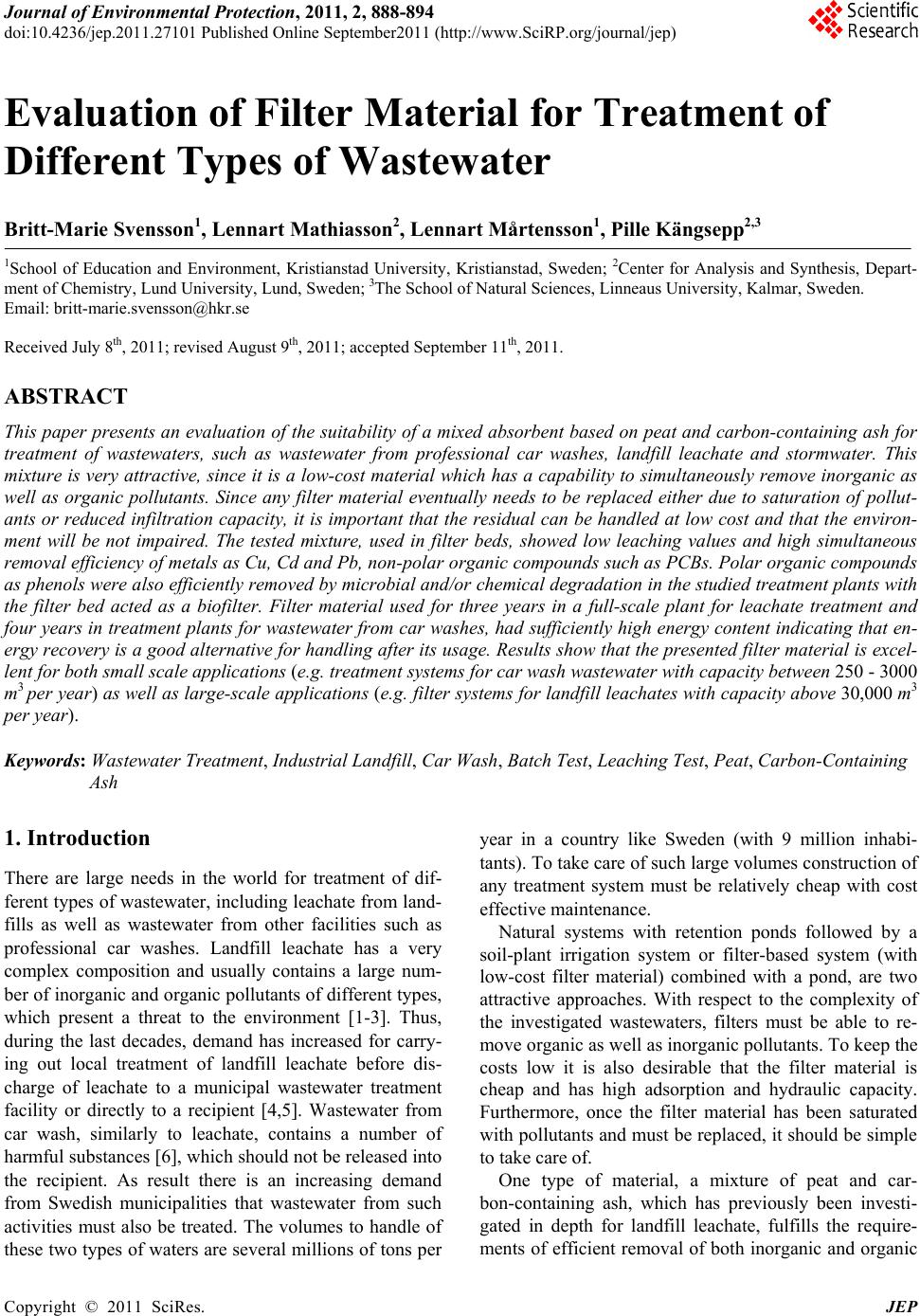 Journal of Environmental Protection, 2011, 2, 888-894 doi:10.4236/jep.2011.27101 Published Online September2011 (http://www.SciRP.org/journal/jep) Copyright © 2011 SciRes. JEP Evaluation of Filter Material for Treatment of Different Types of Wastewater Britt-Marie Svensson1, Lennart Mathiasson2, Lennart Mårtensson1, Pille Kängsepp2,3 1School of Education and Environment, Kristianstad University, Kristianstad, Sweden; 2Center for Analysis and Synthesis, Depart- ment of Chemistry, Lund University, Lund, Sweden; 3The School of Natural Sciences, Linneaus University, Kalmar, Sweden. Email: britt-marie.svensson@hkr.se Received July 8th, 2011; revised August 9th, 2011; accepted September 11th, 2011. ABSTRACT This paper presents an eva luation of the suitability o f a mixed absorbent ba sed on peat and carbon-con taining ash for treatment of wastewaters, such as wastewater from professional car washes, landfill leachate and stormwater. This mixture is very attractive, since it is a low-cost material which has a ca pability to simultaneously remove inorganic as well as organic pollutants. Since any filter material eventually needs to be replaced either due to saturation of pollut- ants or reduced infiltration capacity, it is important that the residual can be handled at low cost and that the environ- ment will be not impaired. The tested mixture, used in filter beds, showed low leaching values and high simultaneous removal efficiency of metals as Cu, Cd and Pb, non-pola r o rganic compound s such as PCBs. Polar organ ic compound s as phenols were also efficiently removed by microbial and/or ch emical degrada tion in the stud ied treatment plan ts with the filter bed acted as a biofilter. Filter material used for three years in a full-scale plant for leachate treatment and four years in treatmen t plants for wastewater from car washes, had sufficien tly high energy content indica ting that en- ergy recovery is a good alternative for handling after its usage. Results show that the presented filter material is excel- lent for both small sca le applicatio ns (e.g. treatmen t systems fo r car wash wastewater with capa city between 250 - 3000 m3 per year) as well as large-scale applications (e.g. filter systems for landfill leachates with capa city above 30,000 m3 per year). Keywords: Wastewater Treatment, Industrial Landfill, Car Wash, Batch Test, Leaching Test, Peat, Carbon-Containing Ash 1. Introduction There are large needs in the world for treatment of dif- ferent types of wastewater, including leachate from land- fills as well as wastewater from other facilities such as professional car washes. Landfill leachate has a very complex composition and usually contains a large num- ber of inorganic and organic pollutants of different types, which present a threat to the environment [1-3]. Thus, during the last decades, demand has increased for carry- ing out local treatment of landfill leachate before dis- charge of leachate to a municipal wastewater treatment facility or directly to a recipient [4,5]. Wastewater from car wash, similarly to leachate, contains a number of harmful substances [6], which should not be released into the recipient. As result there is an increasing demand from Swedish municipalities that wastewater from such activities must also be treated. The volumes to handle of these two types of waters are several millions of tons per year in a country like Sweden (with 9 million inhabi- tants). To take care of such large volumes construction of any treatment system must be relatively cheap with cost effective maintenance. Natural systems with retention ponds followed by a soil-plant irrigation system or filter-based system (with low-cost filter material) combined with a pond, are two attractive approaches. With respect to the complexity of the investigated wastewaters, filters must be able to re- move organic as well as inorganic pollutants. To keep the costs low it is also desirable that the filter material is cheap and has high adsorption and hydraulic capacity. Furthermore, once the filter material has been saturated with pollutants and must be replaced, it should be simple to take care of. One type of material, a mixture of peat and car- bon-containing ash, which has previously been investi- gated in depth for landfill leachate, fulfills the require- ments of efficient removal of both inorganic and organic 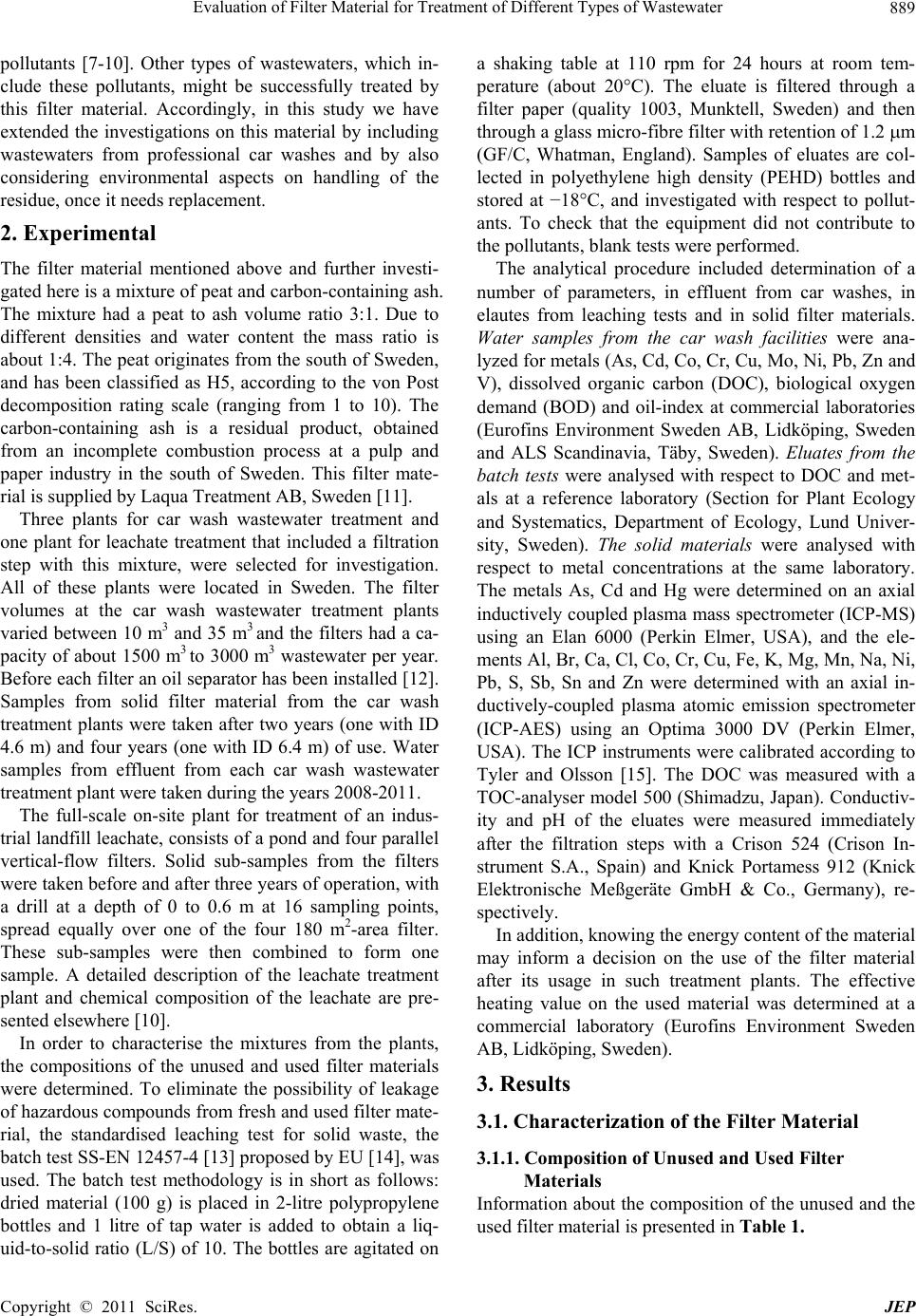 Evaluation of Filter Material for Treatment of Different Types of Wastewater889 pollutants [7-10]. Other types of wastewaters, which in- clude these pollutants, might be successfully treated by this filter material. Accordingly, in this study we have extended the investigations on this material by including wastewaters from professional car washes and by also considering environmental aspects on handling of the residue, once it needs replacement. 2. Experimental The filter material mentioned above and further investi- gated here is a mixture of peat and carbon-containing ash. The mixture had a peat to ash volume ratio 3:1. Due to different densities and water content the mass ratio is about 1:4. The peat originates from the south of Sweden, and has been classified as H5, according to the von Post decomposition rating scale (ranging from 1 to 10). The carbon-containing ash is a residual product, obtained from an incomplete combustion process at a pulp and paper industry in the south of Sweden. This filter mate- rial is supplied by Laqua Treatment AB, Sweden [11]. Three plants for car wash wastewater treatment and one plant for leachate treatment that included a filtration step with this mixture, were selected for investigation. All of these plants were located in Sweden. The filter volumes at the car wash wastewater treatment plants varied between 10 m3 and 35 m3 and the filters had a ca- pacity of about 1500 m3 to 3000 m3 wastewater per year. Before each filter an oil separator has been installed [12]. Samples from solid filter material from the car wash treatment plants were taken after two years (one with ID 4.6 m) and four years (one with ID 6.4 m) of use. Water samples from effluent from each car wash wastewater treatment plant were taken during the years 2008-2011. The full-scale on-site plant for treatment of an indus- trial landfill leachate, consists of a pond and four parallel vertical-flow filters. Solid sub-samples from the filters were taken before and after three years of operation, with a drill at a depth of 0 to 0.6 m at 16 sampling points, spread equally over one of the four 180 m2-area filter. These sub-samples were then combined to form one sample. A detailed description of the leachate treatment plant and chemical composition of the leachate are pre- sented elsewhere [10]. In order to characterise the mixtures from the plants, the compositions of the unused and used filter materials were determined. To eliminate the possibility of leakage of hazardous compounds from fresh and used filter mate- rial, the standardised leaching test for solid waste, the batch test SS-EN 12457-4 [13] proposed by EU [14], was used. The batch test methodology is in short as follows: dried material (100 g) is placed in 2-litre polypropylene bottles and 1 litre of tap water is added to obtain a liq- uid-to-solid ratio (L/S) of 10. The bottles are agitated on a shaking table at 110 rpm for 24 hours at room tem- perature (about 20°C). The eluate is filtered through a filter paper (quality 1003, Munktell, Sweden) and then through a glass micro-fibre filter with retention of 1.2 m (GF/C, Whatman, England). Samples of eluates are col- lected in polyethylene high density (PEHD) bottles and stored at −18C, and investigated with respect to pollut- ants. To check that the equipment did not contribute to the pollutants, blank tests were performed. The analytical procedure included determination of a number of parameters, in effluent from car washes, in elautes from leaching tests and in solid filter materials. Water samples from the car wash facilities were ana- lyzed for metals (As, Cd, Co, Cr, Cu, Mo, Ni, Pb, Zn and V), dissolved organic carbon (DOC), biological oxygen demand (BOD) and oil-index at commercial laboratories (Eurofins Environment Sweden AB, Lidköping, Sweden and ALS Scandinavia, Täby, Sweden). Eluates from the batch tests were analysed with respect to DOC and met- als at a reference laboratory (Section for Plant Ecology and Systematics, Department of Ecology, Lund Univer- sity, Sweden). The solid materials were analysed with respect to metal concentrations at the same laboratory. The metals As, Cd and Hg were determined on an axial inductively coupled plasma mass spectrometer (ICP-MS) using an Elan 6000 (Perkin Elmer, USA), and the ele- ments Al, Br, Ca, Cl, Co, Cr, Cu, Fe, K, Mg, Mn, Na, Ni, Pb, S, Sb, Sn and Zn were determined with an axial in- ductively-coupled plasma atomic emission spectrometer (ICP-AES) using an Optima 3000 DV (Perkin Elmer, USA). The ICP instruments were calibrated according to Tyler and Olsson [15]. The DOC was measured with a TOC-analyser model 500 (Shimadzu, Japan). Conductiv- ity and pH of the eluates were measured immediately after the filtration steps with a Crison 524 (Crison In- strument S.A., Spain) and Knick Portamess 912 (Knick Elektronische Meßgeräte GmbH & Co., Germany), re- spectively. In addition, knowing the energy content of the material may inform a decision on the use of the filter material after its usage in such treatment plants. The effective heating value on the used material was determined at a commercial laboratory (Eurofins Environment Sweden AB, Lidköping, Sweden). 3. Results 3.1. Characterization of the Filter Material 3.1.1. Composition of Unused and Used Filter Materials Information about the composition of the unused and the used filter material is presented in Table 1. Copyright © 2011 SciRes. JEP 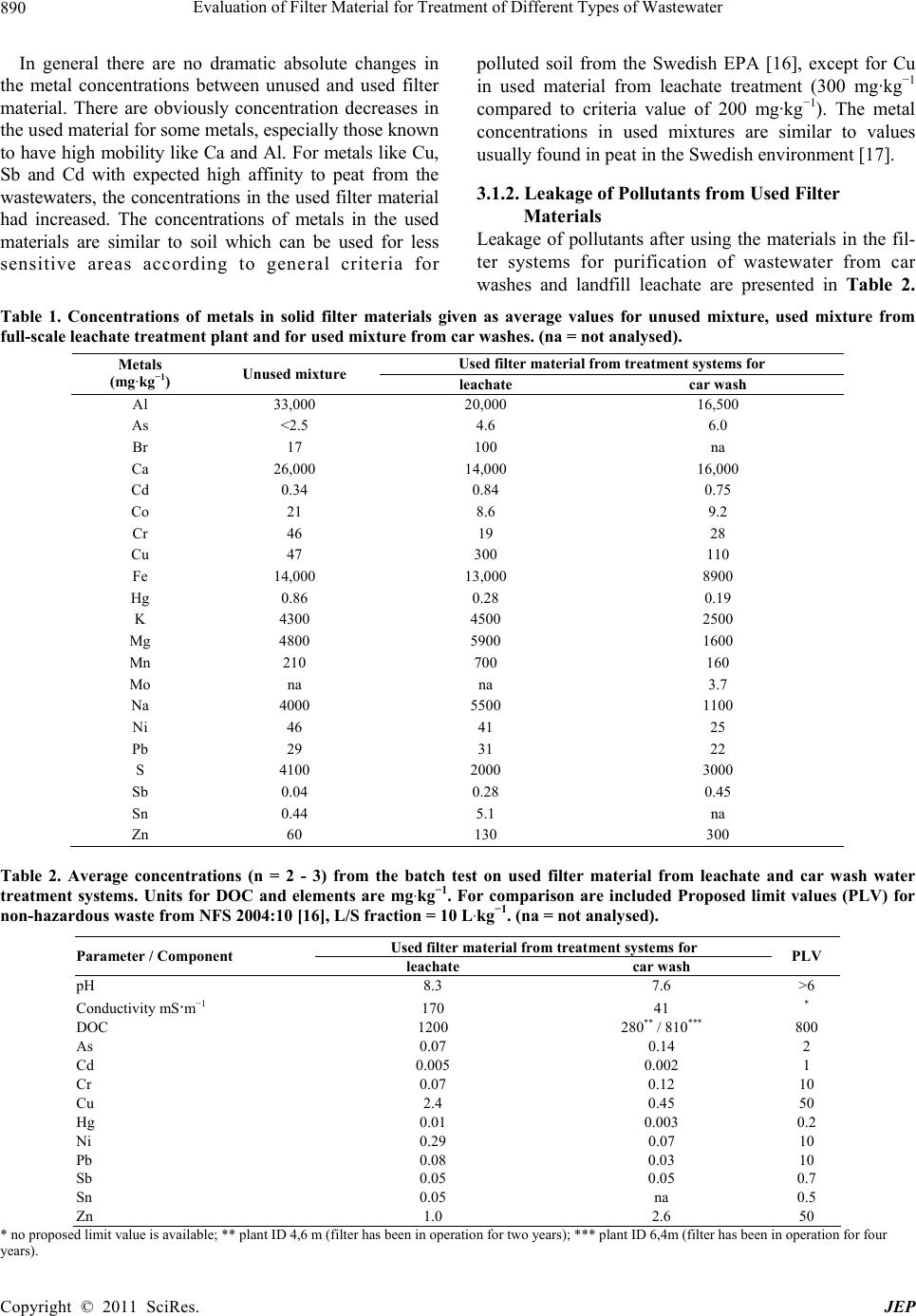 Evaluation of Filter Material for Treatment of Different Types of Wastewater Copyright © 2011 SciRes. JEP 890 In general there are no dramatic absolute changes in the metal concentrations between unused and used filter material. There are obviously concentration decreases in the used material for some metals, especially those known to have high mobility like Ca and Al. For metals like Cu, Sb and Cd with expected high affinity to peat from the wastewaters, the concentrations in the used filter material had increased. The concentrations of metals in the used materials are similar to soil which can be used for less sensitive areas according to general criteria for polluted soil from the Swedish EPA [16], except for Cu in used material from leachate treatment (300 mg·kg−1 compared to criteria value of 200 mg·kg−1). The metal concentrations in used mixtures are similar to values usually found in peat in the Swedish environment [17]. 3.1.2. Leakage of Pollutants from Used Filter Materials Leakage of pollutants after using the materials in the fil- ter systems for purification of wastewater from car washes and landfill leachate are presented in Table 2. Table 1. Concentrations of metals in solid filter materials given as average values for unused mixture, used mixture from full-scale leachate treatment plant and for used mixture from car washes. (na = not analysed). Used filter material from treatment systems for Metals (mg·kg−1) Unused mixture leachate car wash Al 33,000 20,000 16,500 As <2.5 4.6 6.0 Br 17 100 na Ca 26,000 14,000 16,000 Cd 0.34 0.84 0.75 Co 21 8.6 9.2 Cr 46 19 28 Cu 47 300 110 Fe 14,000 13,000 8900 Hg 0.86 0.28 0.19 K 4300 4500 2500 Mg 4800 5900 1600 Mn 210 700 160 Mo na na 3.7 Na 4000 5500 1100 Ni 46 41 25 Pb 29 31 22 S 4100 2000 3000 Sb 0.04 0.28 0.45 Sn 0.44 5.1 na Zn 60 130 300 Table 2. Average concentrations (n = 2 - 3) from the batch test on used filter material from leachate and car wash water treatment systems. Units for DOC and elements are mg·kg−1. For comparison are included Proposed limit values (PLV) for non-hazardous waste from NFS 2004:10 [16], L/S fraction = 10 L·kg−1. (na = not analysed). Used filter material from treatment systems for Parameter / Component leachate car wash PLV pH 8.3 7.6 >6 Conductivity mS·m−1 170 41 * DOC 1200 280** / 810*** 800 As 0.07 0.14 2 Cd 0.005 0.002 1 Cr 0.07 0.12 10 Cu 2.4 0.45 50 Hg 0.01 0.003 0.2 Ni 0.29 0.07 10 Pb 0.08 0.03 10 Sb 0.05 0.05 0.7 Sn 0.05 na 0.5 Zn 1.0 2.6 50 * no proposed limit value is available; ** plant ID 4,6 m (filter has been in operation for two years); *** plant ID 6,4m (filter has been in operation for four years). 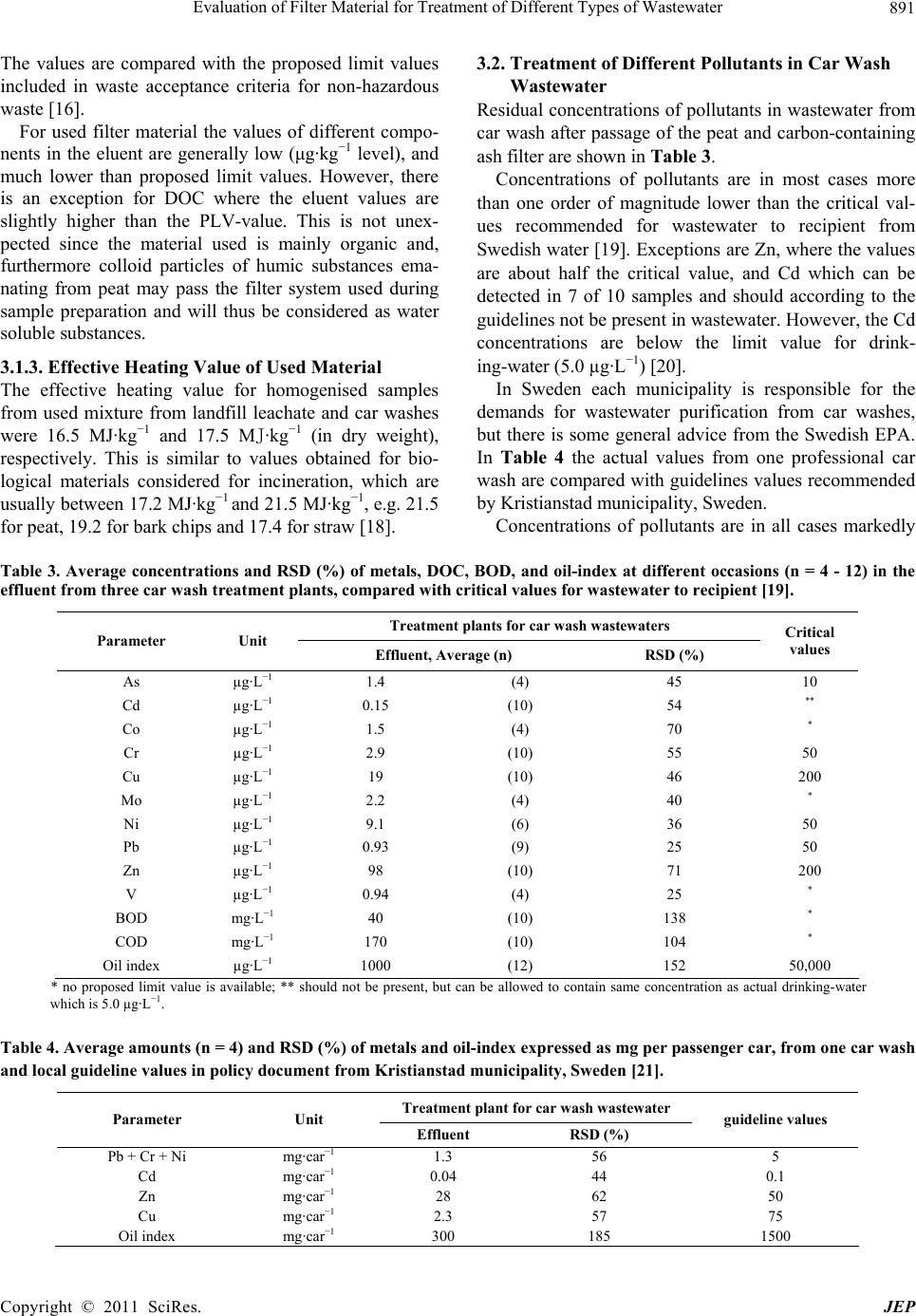 Evaluation of Filter Material for Treatment of Different Types of Wastewater 891 The values are compared with the proposed limit values included in waste acceptance criteria for non-hazardous waste [16]. For used filter material the values of different compo- nents in the eluent are generally low (μg·kg−1 level), and much lower than proposed limit values. However, there is an exception for DOC where the eluent values are slightly higher than the PLV-value. This is not unex- pected since the material used is mainly organic and, furthermore colloid particles of humic substances ema- nating from peat may pass the filter system used during sample preparation and will thus be considered as water soluble substances. 3.1.3. Effective Heating Value of Used Material The effective heating value for homogenised samples from used mixture from landfill leachate and car washes were 16.5 MJ·kg−1 and 17.5 MJ·kg−1 (in dry weight), respectively. This is similar to values obtained for bio- logical materials considered for incineration, which are usually between 17.2 MJ·kg−1 and 21.5 MJ·kg−1, e.g. 21.5 for peat, 19.2 for bark chips and 17.4 for straw [18]. 3.2. Treatment of Different Pollutants in Car Wash Wastewater Residual concentrations of pollutants in wastewater from car wash after passage of the peat and carbon-containing ash filter are shown in Table 3. Concentrations of pollutants are in most cases more than one order of magnitude lower than the critical val- ues recommended for wastewater to recipient from Swedish water [19]. Exceptions are Zn, where the values are about half the critical value, and Cd which can be detected in 7 of 10 samples and should according to the guidelines not be present in wastewater. However, the Cd concentrations are below the limit value for drink- ing-water (5.0 µg·L−1) [20]. In Sweden each municipality is responsible for the demands for wastewater purification from car washes, but there is some general advice from the Swedish EPA. In Table 4 the actual values from one professional car wash are compared with guidelines values recommended by Kristianstad municipality, Sweden. Concentrations of pollutants are in all cases markedly Table 3. Average concentrations and RSD (%) of metals, DOC, BOD, and oil-index at different occasions (n = 4 - 12) in the effluent from three car wash treatment plants, compared with critical values for wastewater to recipient [19]. Treatment plants for car wash wastewaters Parameter Unit Effluent, Average (n) RSD (%) Critical values As µg·L−1 1.4 (4) 45 10 Cd µg·L−1 0.15 (10) 54 ** Co µg·L−1 1.5 (4) 70 * Cr µg·L−1 2.9 (10) 55 50 Cu µg·L−1 19 (10) 46 200 Mo µg·L−1 2.2 (4) 40 * Ni µg·L−1 9.1 (6) 36 50 Pb µg·L−1 0.93 (9) 25 50 Zn µg·L−1 98 (10) 71 200 V µg·L−1 0.94 (4) 25 * BOD mg·L−1 40 (10) 138 * COD mg·L−1 170 (10) 104 * Oil index µg·L−1 1000 (12) 152 50,000 * no proposed limit value is available; ** should not be present, but can be allowed to contain same concentration as actual drinking-water which is 5.0 µg·L−1. Table 4. Average amounts (n = 4) and RSD (%) of metals and oil-index expressed as mg per passenger car, from one car wash and local guideline values in policy document from Kristianstad municipality, Sweden [21]. Treatment plant for car wash wastewater Parameter Unit Effluent RSD (%) guideline values Pb + Cr + Ni mg·car−1 1.3 56 5 Cd mg·car−1 0.04 44 0.1 Zn mg·car−1 28 62 50 Cu mg·car−1 2.3 57 75 Oil index mg·car−1 300 185 1500 Copyright © 2011 SciRes. JEP 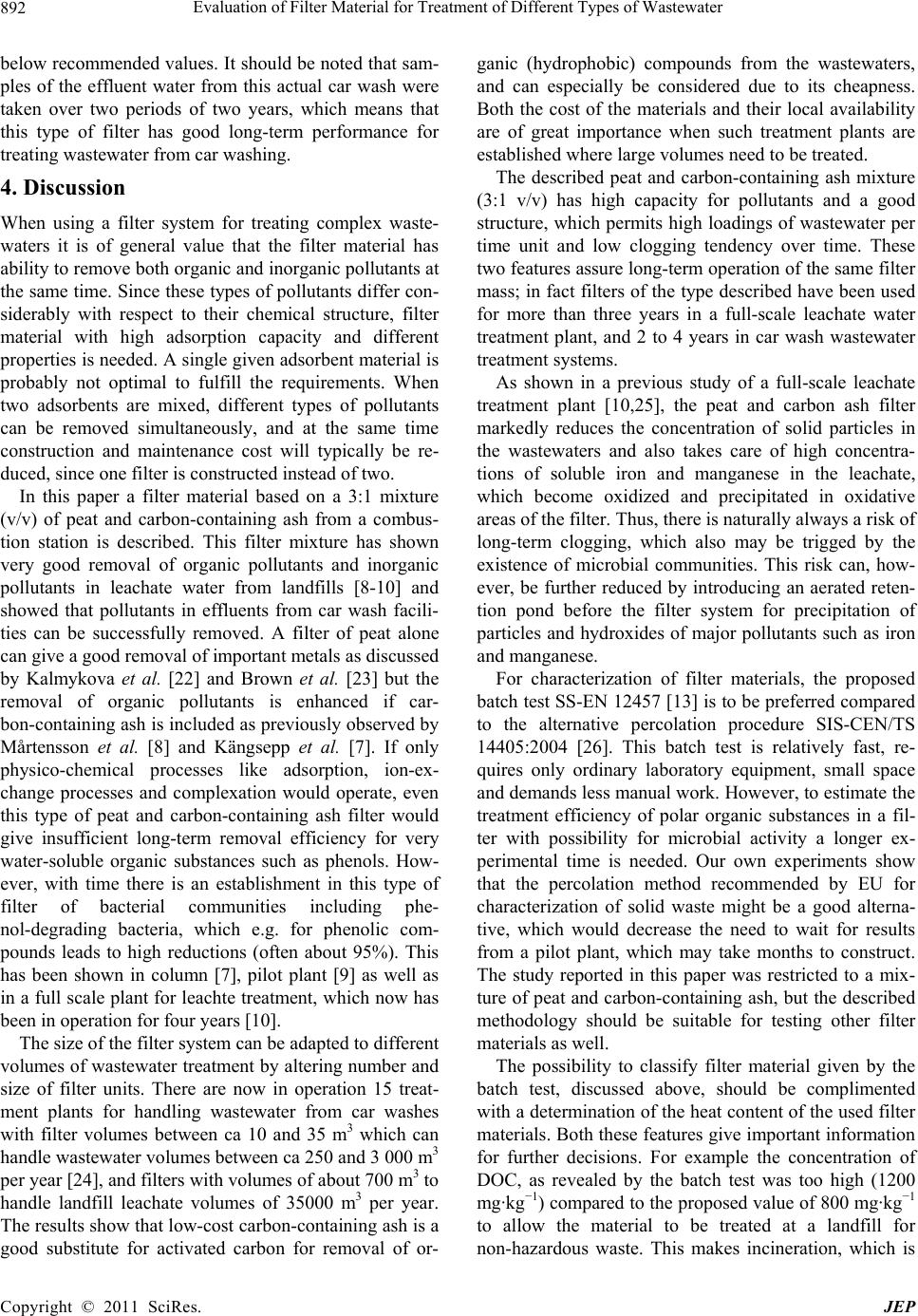 Evaluation of Filter Material for Treatment of Different Types of Wastewater 892 below recommended values. It should be noted that sam- ples of the effluent water from this actual car wash were taken over two periods of two years, which means that this type of filter has good long-term performance for treating wastewater from car washing. 4. Discussion When using a filter system for treating complex waste- waters it is of general value that the filter material has ability to remove both organic and inorganic pollutants at the same time. Since these types of pollutants differ con- siderably with respect to their chemical structure, filter material with high adsorption capacity and different properties is needed. A single given adsorbent material is probably not optimal to fulfill the requirements. When two adsorbents are mixed, different types of pollutants can be removed simultaneously, and at the same time construction and maintenance cost will typically be re- duced, since one filter is constructed instead of two. In this paper a filter material based on a 3:1 mixture (v/v) of peat and carbon-containing ash from a combus- tion station is described. This filter mixture has shown very good removal of organic pollutants and inorganic pollutants in leachate water from landfills [8-10] and showed that pollutants in effluents from car wash facili- ties can be successfully removed. A filter of peat alone can give a good removal of important metals as discussed by Kalmykova et al. [22] and Brown et al. [23] but the removal of organic pollutants is enhanced if car- bon-containing ash is included as previously observed by Mårtensson et al. [8] and Kängsepp et al. [7]. If only physico-chemical processes like adsorption, ion-ex- change processes and complexation would operate, even this type of peat and carbon-containing ash filter would give insufficient long-term removal efficiency for very water-soluble organic substances such as phenols. How- ever, with time there is an establishment in this type of filter of bacterial communities including phe- nol-degrading bacteria, which e.g. for phenolic com- pounds leads to high reductions (often about 95%). This has been shown in column [7], pilot plant [9] as well as in a full scale plant for leachte treatment, which now has been in operation for four years [10]. The size of the filter system can be adapted to different volumes of wastewater treatment by altering number and size of filter units. There are now in operation 15 treat- ment plants for handling wastewater from car washes with filter volumes between ca 10 and 35 m3 which can handle wastewater volumes between ca 250 and 3 000 m3 per year [24], and filters with volumes of about 700 m3 to handle landfill leachate volumes of 35000 m3 per year. The results show that low-cost carbon-containing ash is a good substitute for activated carbon for removal of or- ganic (hydrophobic) compounds from the wastewaters, and can especially be considered due to its cheapness. Both the cost of the materials and their local availability are of great importance when such treatment plants are established where large volumes need to be treated. The described peat and carbon-containing ash mixture (3:1 v/v) has high capacity for pollutants and a good structure, which permits high loadings of wastewater per time unit and low clogging tendency over time. These two features assure long-term operation of the same filter mass; in fact filters of the type described have been used for more than three years in a full-scale leachate water treatment plant, and 2 to 4 years in car wash wastewater treatment systems. As shown in a previous study of a full-scale leachate treatment plant [10,25], the peat and carbon ash filter markedly reduces the concentration of solid particles in the wastewaters and also takes care of high concentra- tions of soluble iron and manganese in the leachate, which become oxidized and precipitated in oxidative areas of the filter. Thus, there is naturally always a risk of long-term clogging, which also may be trigged by the existence of microbial communities. This risk can, how- ever, be further reduced by introducing an aerated reten- tion pond before the filter system for precipitation of particles and hydroxides of major pollutants such as iron and manganese. For characterization of filter materials, the proposed batch test SS-EN 12457 [13] is to be preferred compared to the alternative percolation procedure SIS-CEN/TS 14405:2004 [26]. This batch test is relatively fast, re- quires only ordinary laboratory equipment, small space and demands less manual work. However, to estimate the treatment efficiency of polar organic substances in a fil- ter with possibility for microbial activity a longer ex- perimental time is needed. Our own experiments show that the percolation method recommended by EU for characterization of solid waste might be a good alterna- tive, which would decrease the need to wait for results from a pilot plant, which may take months to construct. The study reported in this paper was restricted to a mix- ture of peat and carbon-containing ash, but the described methodology should be suitable for testing other filter materials as well. The possibility to classify filter material given by the batch test, discussed above, should be complimented with a determination of the heat content of the used filter materials. Both these features give important information for further decisions. For example the concentration of DOC, as revealed by the batch test was too high (1200 mg· kg −1) compared to the proposed value of 800 mg·kg−1 to allow the material to be treated at a landfill for non-hazardous waste. This makes incineration, which is Copyright © 2011 SciRes. JEP  Evaluation of Filter Material for Treatment of Different Types of Wastewater893 also the alternative proposed by the EU, more feasible than landfilling. With all other values of analysed pa- rameters below proposed limit values for hazardous waste, concentrations of metal and high energy content are close to the values normally found in Swedish peat [17], which already is used for energy production. Thus, for the filter material described, incineration in a com- bustion plant offers a low cost, environmentally sound alternative. Furthermore, the technique of co-combustion of peat in fuel blends is already well established in power plants [27]. Anyhow by this approach the life cycle of the residue has been extended. 5. Conclusions The procedure developed for investigating filter materials, based on a combination of a Batch test (SS EN 12457) and a Percolation test (SIS-CEN/TS 14405:2004) for leaching from solid waste recommended by EU, ensures that the material used is appropriate for wastewater treat- ments (i.e. sufficient removal efficiency) and that sound decisions concerning appropriate destruction of used ma- terials can be made. This procedure should be possible to use for other filter based treatment systems as well. The filter material investigated, based on a mixture of peat and carbon-containing ash, can efficiently treat dif- ferent types of wastewaters containing different pollut- ants. The size of the filter is not critical and filter systems with a simple and basically same construction can be used for filter volumes of a few cubic meters (for car wash facilities) up to several hundred cubic meters (for landfill leachate). The high filter capacity for a wide va- riety of pollutants and a structure that minimizes clog- ging tendency makes this type of filter based treatment plants operational for long periods of time (several years) without any need for substitution of the filter material. This gives a good treatment economy. Once the used material is replaced its good energy value makes it con- venient to destruct at a low price in an incineration plant for energy production. Altogether this should make the filter material presented useful for many types of waste- waters. 6. Acknowledgements The authors acknowledge the financial support of Stena Recycling AB (Sweden) and the Knowledge Foundation (Sweden). S Söderlund, M Eliasson and L Ivarsson (di- ploma workers at Kristianstad University, Sweden) are acknowledged for help with sampling and laboratory work. REFERENCES [1] P. Kjeldsen, et al. , “Present and Long-Term Composition of MSW Landfill Leachate: A Review,” Critical Reviews in Environmental Science and Technology, Vol. 32, No. 4, 2002, pp. 297-336. [2] C. Öman, et al., “Development of Methods for Charac- terisation of Landfill Leachates—Final Report,” IVL Swedish Environmental Research Institute Ltd., Stock- holm, Vol. B-1353, 2000. [3] C. B. Öman and C. Junestedt, “Chemical Characterization of Landfill Leachates—400 Parameters and Compounds,” Waste Management, Vol. 28, No. 10, 2008, pp. 1876-1891. [4] Swedish EPA, “Leachate from Landfills,” Swedish Envi- ronmental Protection Agency: Naturvårdsverket, Stock- holm, Sweden, Vol. 8306, 2008. [5] J. M. Lema, et al., “Characteristics of Landfill Leachate and Alternatives for Their Treatment: A Review,” Water Air and Soil Pollution, Vol. 40, 1988, pp. 223-250. [6] Swedish EPA, “Fordonstvättar. Utgåva 1”, 2005. http://www.naturvardsverket.se/Documents/publikationer /620-8207-8.pdf [7] P. Kängsepp, et al., “Column Studies Aiming at Identifi- cation of Suitable Filter Materials for Pollutant Removal from Landfill Leachate,” International Journal of Envi- ronment and Waste Management, Vol. 2, No. 6, 2008, pp. 506-525. doi:10.1504/IJEWM.2008.021856 [8] L. Mårtensson, et al., “Development and Application of an Analytical Protocol for Evaluation of Treatment Proc- esses for Landfill Leachates. II. Evaluation of Leachate Treatment Efficiency of Different Steps in a Constructed Pilot Plant,” International Journal of Environmental Analytical Chemistry, Vol. 87, No. 1, 2007, pp. 17-27. doi:10.1080/03067310600929233 [9] P. Kängsepp, et al., “Filter-Based Treatment of Leachate from an Industrial Landfill Containing Shredder Residues of End-Of-Life Vehicles and White Goods,” Waste Man- agement, Vol. 30, No. 2, 2010, pp. 236-245. doi:10.1016/j.wasman.2009.08.005 [10] P. Kängsepp and L. Mathiasson, “Performance of a Full-Scale Biofilter with Peat and Ash as a Medium for Treating Industrial Landfill Leachate: A 3-Year Study of Pollutant Removal Efficiency,” Waste Management & Research, Vol. 27, No. 2, 2009, pp. 147-158. doi:10.1177/0734242X08095232 [11] D. Rosenqvist, Laqua Treatment AB, 2011. http://www.laqua.se/index_en.php [12] D. Rosenqvist, Laqua Wash, 2011. http://www.laqua.se/index_en.php?m=fs_fordonstvatt&p [13] Swedish Standard Institute, “Characterisation of Waste— Leaching—Compliance Test for Leaching of Granular Waste Materials and Sludges—Part 4”, SS-EN 12457-4, 2003. [14] Council Decision of 19 December 2002, Establishing Criteria and Procedures for the Acceptance of Waste at Landfills Pursuant to Article 16 of and Annex II to Direc- tive 1999/31/EC, 2003/33/EC. [15] G. Tyler and T. Olsson, “Conditions Related to Solubility of Rare and Minor Elements in Forest Soils,” Journal of Copyright © 2011 SciRes. JEP  Evaluation of Filter Material for Treatment of Different Types of Wastewater Copyright © 2011 SciRes. JEP 894 Plant Nutrition and Soil Science, Vol. 165, 2002, pp. 594-601. [16] Swedish EPA, “Naturvårdsverkets föreskrifter om deponering, kriterier och förfaranden för mottagning av avfall vid anläggningar för deponering av avfall,” Swedish Environmental Protection Agency, Vol. NFS 2004:10, 2004. [17] SGU, “Torv - kemisk sammansättning,” 2011. http://www.sgu.se/sgu/sv/samhalle/energi-klimat/torv/tor v-kemi.html [18] Bioenergiportalen, “Exempel på bränsledata för olika bränslen”, 2011. http://www.bioenergiportalen.se/?p=1590 [19] Swedish Water, “Publication P95, Råd vid mottagande av avloppsvatten från industri och annan verksamhet,” The Swedish Water & Wastewater Association, SWWA, 2009. [20] National Food Administration, “Livsmedelsverkets förordning (2001:30) om dricksvatten”, Livsmedelsverket, Vol. SLVFS 2001:30, 2001. [21] Kristianstad Municipality, “Policy för krav på rening av avloppsvatten från fordonstvättar,” 2005. http://www.kristianstad.se/upload/Malgrupper/Foretag/do kument/lagar_vagledning/miljoskydd/Policybiltvatt.pdf [22] Y. Kalmykova, et al., “Adsorption of Cd, Cu, Ni, Pb and Zn on Sphagnum Peat from Solutions with Low Metal Concentrations,” Journal of Hazardous Materials, Vol. 152, No. 2, 2008, pp. 885-891. doi:10.1016/j.jhazmat.2007.07.062 [23] P. A. Brown, et al., “Metal Removal from Wastewater Using Peat,” Water Research, Vol. 34, No. 16, 2000, pp. 3907-3916. doi:10.1016/S0043-1354(00)00152-4 [24] D. Rosenqvist, Laqua Treatment AB, 2011. (personal communication 2011-05-06) [25] P. Kängsepp, et al., “Hydraulic Performance of a Full-Scale Peat and Ash Biofilter in Treatment of Indus- trial Landfill Leachate,” Waste Management & Research, Vol. 27, No. 5, 2009, pp. 512-519. doi:10.1177/0734242X08096138 [26] Swedish Standard Institute, “Characterisation of Waste— Leaching Behaviour Tests—Up-Flow Percolation Test,” SS-EN 14405:2004, 2004. [27] J. Burvall and M. Öhman, “Co-Combustion of Peat and Biofuels,” (Samförbränning av torv och biobränslen - askrelaterade systemfördelar), Statens energimyndighet, Sweden, 2006.
|